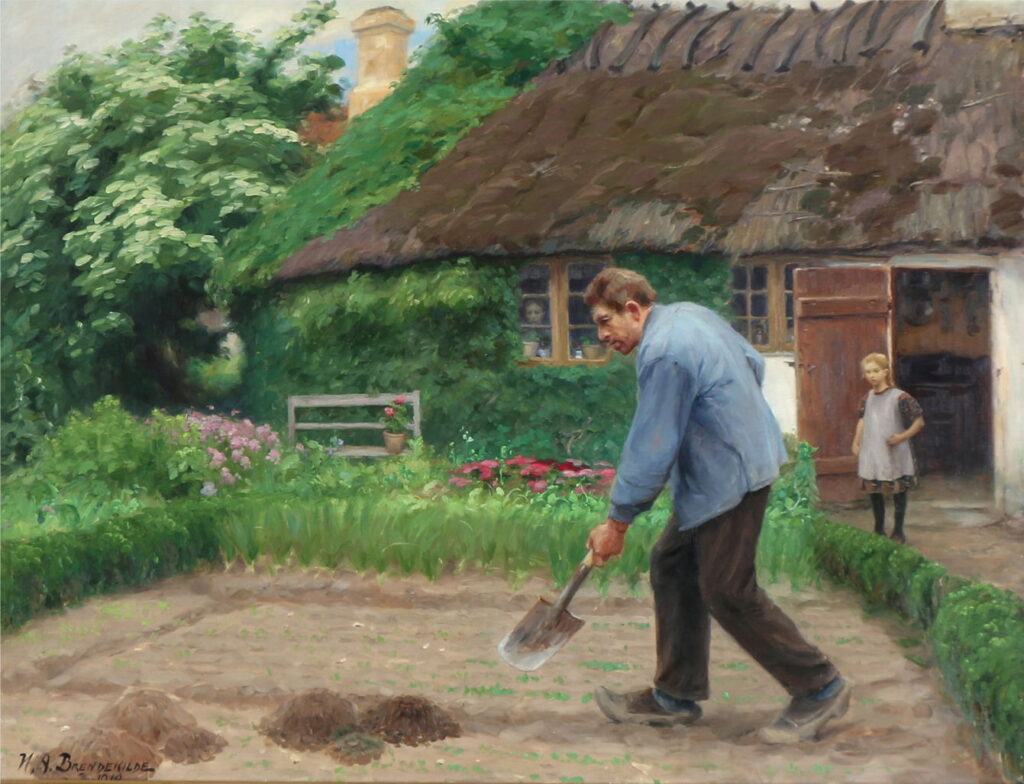Painting the gardener 2 1800-1941

During the era of patronage in art, covered in the first article of these two, gardeners were depicted in stories from myth and the New Testament. Patrons were hardly going to pay to have their domestic staff painted. In the last half of the nineteenth century, this changed as more paintings were sold from the Salon and galleries to a wider range of buyers.
Briton Rivière (1840-1920), The Old Gardener (1863), oil on canvas, 27.6 x 38.1 cm, Yale Center for British Art, New Haven, CT. Wikimedia Commons.
By 1863, when he painted The Old Gardener, Briton Rivière was making a name for himself with his popular genre paintings. At this stage, animals were just another part of the whole scene, as is the small dog sat beside this old man as he dozes in his shed, next to a rickety wheelbarrow that has seen better days.
Frédéric Bazille (1841–1870), The Little Gardener (1865-67), oil on canvas, 128 x 168.9 cm, Museum of Fine Arts, Houston, TX. Wikimedia Commons.
Early in his career Frédéric Bazille started to paint The Little Gardener (1865-67), but seems to have abandoned it with the foreground incomplete. It shows a youth pouring liquid from a large flask, as he tends the flowers in what’s probably the family garden.
Alfred Sisley (1839–1899), Fog, Voisins (1874), oil on canvas, 50.5 x 65 cm, Musée d’Orsay, Paris. EHN & DIJ Oakley.
Alfred Sisley’s fog-cloaked flowerbed in the foreground is a small patch of colour in this garden. The woman working away isn’t tending her nasturtiums, but toiling away at what will, in a few months time, be carefully prepared and cooked in her kitchen, as an important supplement to her diet.
Gustave Caillebotte (1848–1894), The Gardeners (1875), further details not known. Wikimedia Commons.
Gustave Caillebotte’s gardening became so serious that it was something of an obsession. He painted the large vegetable gardens that fed the estates of the rich, as in The Gardeners from 1875. Although by that time most urban areas in France had a piped water supply, those seldom extended to country estates, and watering plants still had to be performed manually.
Camille Pissarro (1830–1903), Peasant Woman Digging, the Jardin de Maubuisson, Pontoise (1881), oil on canvas, 46 x 55 cm, Private collection. Wikimedia Commons.
Camille Pissarro’s Peasant Woman Digging, the Jardin de Maubuisson, Pontoise (1881) shows two women working in the vegetable garden of this large house in the village of Pontoise. This painting was first shown at the seventh Impressionist Exhibition.
Emil Jakob Schindler (1842–1892), Vegetable garden in Plankenberg in September (1885), media and dimensions not known, Staatsgemäldesammlungen, Munich, Germany. Wikimedia Commons.
Emil Jakob Schindler shows a more typical rural Vegetable Garden in Plankenberg in September (1885), with its small patches of a wide range of produce, and a mother being supervised by one of her children.
Emile Claus (1849-1924), The Old Gardener (1885), oil on canvas, 214 x 138 cm, Musée d’Arts moderne et d’Art contemporain, Liège. WikiArt.
Of all these paintings, it’s Emile Claus’s Old Gardener from 1885 that best captures the hard-worn old man who knew just how grow the best flowers and vegetables for the upper middle class.
Sir George Clausen (1852–1944), A Frosty March Morning (1904), oil on canvas, 63.5 x 76.2 cm, The Tate Gallery (Presented by C.N. Luxmoore 1929), London. Photographic Rights © Tate 2016, CC-BY-NC-ND 3.0 (Unported), http://www.tate.org.uk/art/artworks/clausen-a-frosty-march-morning-n04485
George Clausen’s gardeners are preparing the soil on a frosty morning in March. As they live in a town, they have to work surrogate plots in allotments, small portions of land unsuitable for dwellings, or (in this case) divided from fields at the edge of the town. For many living in towns and cities, a trip to the family allotment was the closest they’d get to going to the country, a brief retreat to escape factories and crowds, and dream of living in more pastoral places. Even small allotments could be decisive to a family’s food supply.
Nikolai Astrup (1880–1928), A Night in Spring (1909), oil on canvas, 86 × 105 cm, Bergen Kunstmuseum, KODE, Bergen, Norway. Wikimedia Commons.
In the more extreme climates of the Nordic countries, vegetable gardens remained essential to nutrition and life. Nikolai Astrup shows a couple sowing their small patch in western Norway on A Night in Spring from 1909.
Nikolai Astrup (1880–1928), Rabarbra (Rhubarb) (1911), oil on canvas, 93 x 110 cm, Bergen Kunstmuseum, KODE, Bergen, Norway. Wikimedia Commons.
Then late in the summer, Astrup shows them returning to harvest that most unglamorous of crops, Rhubarb (1911).
Hans Andersen Brendekilde (1857–1942), Afternoon Work (1918), oil on canvas, 77 x 100 cm, Private collection. Wikimedia Commons.
At the end of the First World War, Hans Andersen Brendekilde painted a gardening story, in Afternoon Work (1918). A younger man is out on his finely-tilled vegetable patch in front of his thatched cottage. Standing just outside the door, behind him, is his young daughter, and through the window is an older woman, presumably his wife. Both are watching him intently, with an air of fear at what he is about to do. His face shows the grim determination of a gardener about to attack a small crop of fresh molehills in the midst of his vegetable seedlings.
Grant Wood (1891–1942), Spring in Town (1941), oil on wood, 66 x 62.2 cm, Swope Art Museum, Terre Haute, IN. Wikimedia Commons.
Finally, Grant Wood’s Spring in Town from 1941 shows locals out in the warm sunshine of the Spring of the American rural Midwest, tending to their yards.




